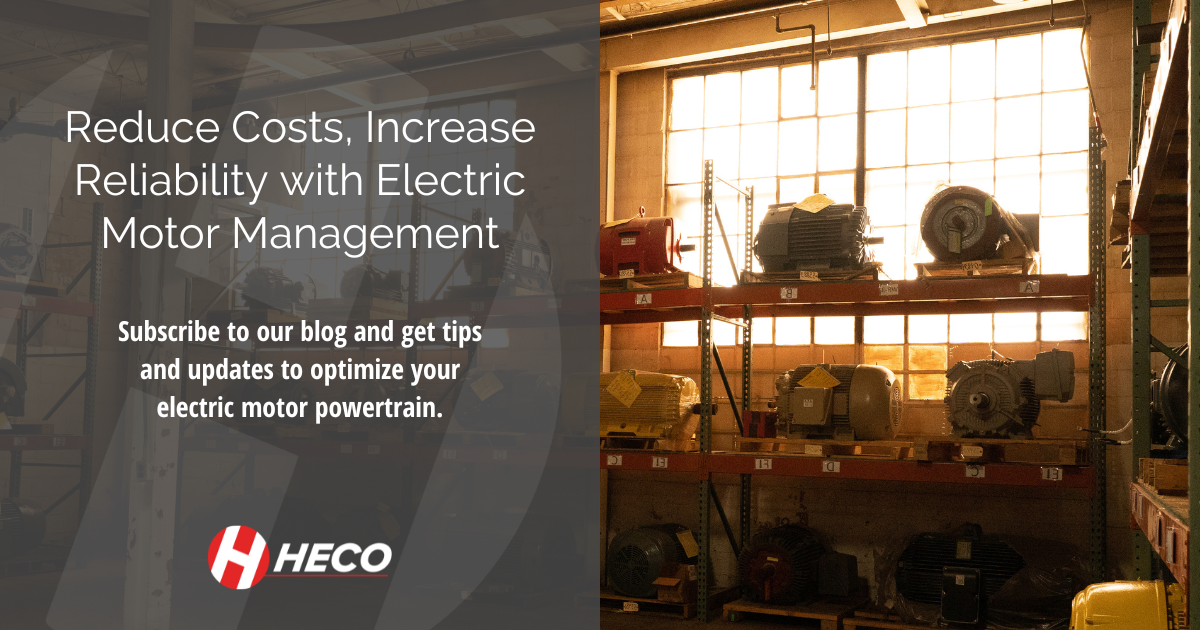Reduce Costs, Increase Reliability with Electric Motor Management - HECO
March 13, 2024
Regardless of your specific operation, there are numerous systems in place to keep your facility running smoothly and efficiently. At HECO, we strongly urge placing an active Equipment Management System (EMS) at the top of your list of priorities.
A good Equipment Management System is not a passive program. It should include a proactive approach to managing spare assets, data, specifications, vendors, and repairs as well as Predictive Maintenance.
The cost of your equipment management program will be worth it when a failure happens and a viable spare is ready for use, preserving uptime and saving costs.
Mind Your Storage
What does your current spare motor storage process entail?
Are electric motors sitting on the ground next to in-service equipment with an overhead pipe leaking and constant vibration destroying the bearings? (We’ve seen that.)
Or do you maintain a temperature-controlled warehouse where everything is neatly arranged and follows a maintenance schedule that includes rotating shafts and checking the insulation resistance of the motors?
One of these scenarios is much more likely to produce a viable spare at a critical moment. Which would you rather experience?
Catalog Your Inventory
Equipment Management programs like these are completely scalable for just about every facility type. At a minimum, you should have a database of all motors in your plant and perform a critical asset assessment to determine what motors are truly needed and in what quantities to maintain operations in the event of a failure.
Eliminating unnecessary inventory is an immediate cost-cutting tool that should be a part of any Equipment Management program.
To help catalog inventory, HECO utilizes TracRat, a proprietary software designed for tracking equipment inventory and the history of movement, repairs, and motor failure types. With this program, we go beyond managing spare inventory to enable instant access to your asset information from anywhere. In a failure situation, having all the information on the failing motor available at the click of a button can go a long way towards locating an adequate replacement in the least amount of time possible.
Make a Plan
Once you have a good idea of what your spare inventory should look like, you can then decide which approach would make the most sense for your plant. The spectrum runs from a staffed warehouse performing checks for you, handling repair situations, and qualifying returned repairs, to someone coming through and surveying and tagging your inventory for reference. (And HECO can help with both!)
Equipment Management is more than simple warehousing; that’s just storage and provides no guarantee of viability and little data. Equipment Management done appropriately is an active operation.
Consider This
Let’s imagine two scenarios involving a motor failure.
Plant ABC has run into a bit of trouble with a crane motor. Overnight, the motor blew its winding and took down the main product crane. Now, they’re losing money every minute production is down.
Understanding that this crane motor is critical to their operation, they have a spare on site for situations just like this. The maintenance crew grabs the motor from the next building over, gets it installed, and they’re back in production.
Next, they send the failed unit out for repair. The motor has a special winding design, so the coil lead time is out about 45 days. However, after just nine days, the spare unit has an unfortunate bearing failure and catastrophically fails. It turned out that while the critical spare was on site, it had been sitting untouched for an extended period of time. Now there is a mad scramble to get something done quickly.
Plant XYZ runs into the same initial problem. In this scenario, the maintenance crew calls the warehouse manager to request the spare ASAP. Within 90 minutes, the spare unit is delivered and the failed unit is taken to be sent off for repair.
The newly installed spare has been maintained, electrically tested, and had its shaft rotated at regular intervals, and a previous repair was validated to ensure its reliability. Approximately 45 days later, as XYZ’s spare motor continues to run perfectly, the replacement coils are received and the original failed unit enters the repair process. After repair, the original unit is returned to the warehouse where it is inspected and will sit safely on the shelf until it’s needed.
If the first scenario is more recognizable to you, you may need to examine your facility’s processes, specifically your Equipment Management approach. The peace of mind that comes from having confidence in your motors’ ability to perform when they’re needed absolutely outweighs the stress of not knowing and figuring it out when it’s too late.
All Systems Go
With decades of experience selling, servicing, monitoring, and storing electric motors and rotating equipment, HECO has the expertise you need to develop a cost-saving, reliability-focused Equipment Management program tailored to your operation and facility.
Contact us to discuss your current situation, past issues, and future goals for reliability, uptime, and efficiency.
Posted in Equipment Management
